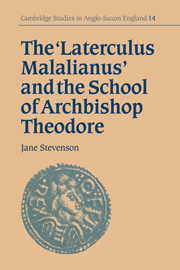Book contents
- Frontmatter
- Contents
- Preface
- List of abbreviations
- 1 Introduction
- 2 The contents of the Laterculus
- 3 Date and origin of the Laterculus
- 4 The nature of the Laterculus
- 5 Sources of the Laterculus
- 6 The Latinity of the Laterculus
- 7 Translational technique of the Laterculus
- 8 Manuscripts
- 9 Conclusion
- Text and Translation
- Commentary
- Appendix: Variant and anomalous biblical texts
- Bibliography
- Index of biblical sources
- General Index
7 - Translational technique of the Laterculus
Published online by Cambridge University Press: 20 March 2010
- Frontmatter
- Contents
- Preface
- List of abbreviations
- 1 Introduction
- 2 The contents of the Laterculus
- 3 Date and origin of the Laterculus
- 4 The nature of the Laterculus
- 5 Sources of the Laterculus
- 6 The Latinity of the Laterculus
- 7 Translational technique of the Laterculus
- 8 Manuscripts
- 9 Conclusion
- Text and Translation
- Commentary
- Appendix: Variant and anomalous biblical texts
- Bibliography
- Index of biblical sources
- General Index
Summary
Another major aspect of the Latinity of the Laterculus which has not yet been discussed is the author's aims and methods in translation from Greek. His work must be set against a background of the concepts of translation and paraphrase relevant to the early medieval west, and in particular, illuminated by the use of Greek in the monastic and papal circles of Rome.
The first impression which one gets from the Malalas translation in the Laterculus is that it is appallingly literal. Insofar as the Laterculus is based on Malalas's Chronographia, it sticks close to its source, though the author felt free to interpolate additional material. His translation technique is not consistent. Some sentences are recast into a Latinate form, within the limitations of his grasp of the language. Others translate whole clauses word by word, keeping the original cases, and producing a result which is effectively a compromise between the two languages. Features of Greek syntax, such as genitive absolute clauses, are taken over completely unchanged from the Chronographia to the Laterculus. Several curious phrases in the Malalian sections of the Laterculus can be explained by looking at the Greek. The un-Latin phrase ex consolibus for exconsule, an ex-consul, is a Latin caique on Greek ἀπò ὑπáτων, and the phrase ‘ut Moyses … exposuit in suis monumentis’ (ch. 3) becomes explicable when we see that Malalas's phrase is ἐν τοîζ ὑπομνήμασιν, and that the meaning of ὑπóμνημα is basically ‘memorial, memorandum’, though it also embraces the meanings ‘treatise’ and ‘commentary’.
- Type
- Chapter
- Information
- Publisher: Cambridge University PressPrint publication year: 1995



